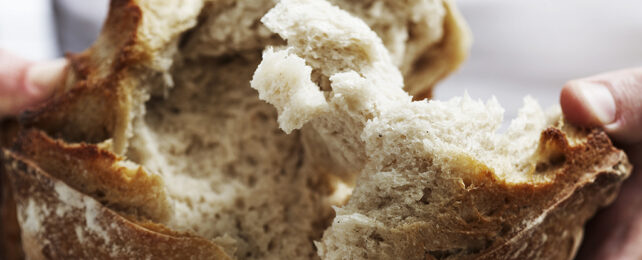Scientists have used a specially engineered flour to make a bread that keeps you fuller for longer and lowers blood glucose levels, potentially offering a healthier alternative that lowers the risk of obesity and diabetes.
The new flour is based on pulses, which include chickpeas, lentils, and beans. Already known to be useful for helping us maintain a healthy weight and reduce the risk of heart disease, the benefits largely rely on the plant material retaining its integrity. In the production of ordinary wheat flour, the advantages of this fiber structure are believed to thanks to the milling process.
"At a time that we are all being encouraged to increase our fiber intake, this study highlights the importance of the physical form of fiber, as intact cell walls, in slowing starch digestion, improving blood glucose levels and simulating satiety hormones help us feel full," says biochemist Peter Ellis, from King's College London in the UK.
After producing their flour and baking their bread, the researchers tested it on 20 healthy individuals, who were served up samples of white bread with 0 percent, 30 percent, and 60 percent of chickpea flour in them. Jam with no added sugar was added for flavor.
The chickpea-enhanced bread tended to make the volunteers feel fuller according to their own self-reporting. Blood analysis suggested this was the result of an increased release of hormones that promoted satiety.
Then there was the blood glucose reduction: the 30 percent chickpea flour reduced blood glucose levels by up to 40 percent, with a drop of almost as much observed from the 60 percent chickpea flour compared to regular flour. That's down to the starch taking longer to break down in the body, the researchers say.
"We were impressed with the results we've seen in healthy individuals, and now would like to see how our cellular chickpea flour bread can help in the management of body weight or diabetes in larger scale dietary intervention trials with people who suffer with these conditions," says gut physiologist Balazs Bajka, from King's College London.
In their published study, the researchers note getting people to change their eating habits to prevent and tackle potential problems such as obesity and diabetes can be difficult – which is the reason that advancements like this are so promising.
Staple foods like bread could be engineered to be better for us, which would require no real effort on our part. Generally eating foods that require less processing has consistently been shown to be the way to go for a longer, healthier life.
This is the first study of its type, demonstrating how the use of whole-cell pulse flour in bread can have these beneficial effects. There's lots more to come though: the same approach could potentially be used on other food types as well.
"We have long known that the structure of food can have a big impact on its nutritional value," says bioscientist Cathrina Edwards, from the Quadram Institute in the UK. "This study is a promising example of how new ingredient structures can be used successfully to improve the metabolic and fullness effects of everyday food products."
"We hope that our findings will attract interest from food producers looking to improve the health credentials of their products."
The research has been published in the American Journal of Clinical Nutrition.
